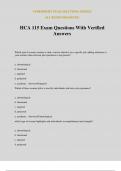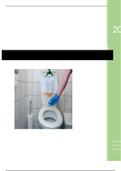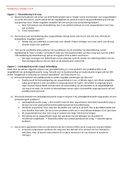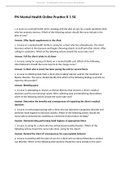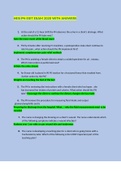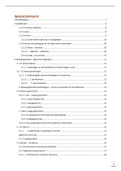Stress, Health and Disease Notes
Lecture 1: Stress Response and Evolution
Ch 1,2,3, R 1
Stressor every possible threat to the attainment of psychobiological goals
Stress Response adaptive psychobiological reaction to a stressor
- Negative emotional psychobiological response
Stress Responses:
- Psychological negative emotions, anger, anxiety, depression
- Bodily heart palpitations, sweating, muscles contract, faster breathing, dry mouth,
tremble. nausea. Stomach issues
Stress is a worldwide epidemic, 70-80% of doctor visits caused by stress
Acute stress response chronic stress response dysregulation tissue damage,
lowered defense organic disease
Nearly every disease seems to have a higher chance of occurrence when organisms are
chronically stressed
Psychobiological routes of stress:
- Health behavior route (indirect route) involves external factors e.g. stress can
cause us to smoke more or drink more
- Many different indirect routes
- Direct route from stress via its psychobiological effects to disease
Important figures through history:
William James mind and body always linked in everything- nothing that happens in the
mind does not have an effect on the body
Cannon (1932) fight/ flight response- fast reaction adrenaline (epinephrine) response
to psychological stress
- No place for fight or flight in human world- can lead to chronic stress
Selye (1956) stress response to physical and psychological threat – non specific
response
- Gluco-corticosteroids (cortisol)
Main messages:
1. Brief stress is okay but prolonged and frequent stress is bad
2. Stress response is phylogenetically old ( generally the same for all animals including
humans)
- Stress response is functional reaction to any conceivable threat- from physical to
psychological- and on any conceivable level- from molecular to macro social
3. Psychological score of stressor = uncontrollability or unpredictability
4. Function of Biological stress response (fight or flight):
- Transport oxygen and fuel to muscles
- Save fuel and building material by suppressing other bodily activity
- Limiting damage and negative sensations
5. Stress in humans: preparation but without action!
,Stress response:
Regardless how complex or culturally determined human stressors seem to be, effects
on body via old biological and basal psychological routes
3 consequences of old phylogenetic stress response
1) function is still- remove the threat or escape,
2) effect on the body via biological routes shared with other animals,
3) effect on body also via old basal psychological factors
Basal psychological factors that determine stress on body:
- Stressor dimensions adversity (nature of threat, uncontrollability and
unpredictability, duration
- Response patterns fight/flight and giving up/ withdraw
Adversity:
- Physical direct threat by physical integrity eg. Cold, heat. Toxins. Infections,
bleeding, violence, hunger, thirst, exhaustion, sleep deprivation
- Psychological perceived threat of physical integrity or psychological integrity eg.
Security, safety, belongingness, intimacy, sex, autonomy, prestige, self actualization
- Threat for humans are often social
Uncontrollability and Unpredictability:
- Experiment with rat where they can control electric shock or not
- Effects of uncontrollability in experiments stomach/intestinal ulcers, high stress
hormones, depleted storage of neurotransmitters in the brain, suppression of
immune responses- unpredictability has similar negative effects
- Uncontrollability of reward can also be stressful
- Duration of the response
Fight or Flight action need physiological response = bodily exercise response +
perceived adversity + decreased control negative emotions
- Preparation for action
- Maintenance of action
- Meant to regain control of the situation
During a stress response your body reacts much like the exercise response with
increased heart rate and increase blood pressure
Comparing stress with other causes of disease:
Biological vulnerabilities heritable factors, acquired bodily conditions (pregnancy),
disease agents and other direct disease triggers (bacteria)
Physical Vulnerabilities physical stressors such as extreme temperatures or
dangerous environments, physical violence, accidents, undernourishment
Psychological Vulnerabilities psychological stressors (poor living conditions, life
events, illnesses, hassles, emotions, worry), health cognitions (symptom perception,
beliefs about risk), health behavior (smoking)
The Nervous System:
, Basic Physiology of stress response:
HPAC hypothalamus pituitary adrenal cortical system
- Hypothalamus CRH Pituitary ACTH Adrenal Cortex Cortisol organs
- Sustaining SAM effects, suppressing immune activity and other non-essential
activity, save energy, to support fight/flight action, no interference of pain experience
with action
SAM Sympathetic Adrenal Medullary System
- Sympathetic NS Adrenal Medulla Adrenaline Organs
- Increased heart rate and blood pressure, local constriction of peripheral blood
vessels, preparation for action, more glucose, more sweating
Consequences:
Consequences of chronic high SAM activity excessive parasympathetic inhibition and
sympathetic arousal and nor adrenaline distorts
- Blood pressure regulation hypertension
- Heart Rhythm sudden death
- More lipids/ free fatty acids in blood atherosclerosis
- Cellular immunity immunological disorders, infections and allergies
Consequences of HPAC:
- Prolonged immunosuppression infections, cancer
- Slower growth, faster aging, etc..
Lecture 1: Stress Response and Evolution
Ch 1,2,3, R 1
Stressor every possible threat to the attainment of psychobiological goals
Stress Response adaptive psychobiological reaction to a stressor
- Negative emotional psychobiological response
Stress Responses:
- Psychological negative emotions, anger, anxiety, depression
- Bodily heart palpitations, sweating, muscles contract, faster breathing, dry mouth,
tremble. nausea. Stomach issues
Stress is a worldwide epidemic, 70-80% of doctor visits caused by stress
Acute stress response chronic stress response dysregulation tissue damage,
lowered defense organic disease
Nearly every disease seems to have a higher chance of occurrence when organisms are
chronically stressed
Psychobiological routes of stress:
- Health behavior route (indirect route) involves external factors e.g. stress can
cause us to smoke more or drink more
- Many different indirect routes
- Direct route from stress via its psychobiological effects to disease
Important figures through history:
William James mind and body always linked in everything- nothing that happens in the
mind does not have an effect on the body
Cannon (1932) fight/ flight response- fast reaction adrenaline (epinephrine) response
to psychological stress
- No place for fight or flight in human world- can lead to chronic stress
Selye (1956) stress response to physical and psychological threat – non specific
response
- Gluco-corticosteroids (cortisol)
Main messages:
1. Brief stress is okay but prolonged and frequent stress is bad
2. Stress response is phylogenetically old ( generally the same for all animals including
humans)
- Stress response is functional reaction to any conceivable threat- from physical to
psychological- and on any conceivable level- from molecular to macro social
3. Psychological score of stressor = uncontrollability or unpredictability
4. Function of Biological stress response (fight or flight):
- Transport oxygen and fuel to muscles
- Save fuel and building material by suppressing other bodily activity
- Limiting damage and negative sensations
5. Stress in humans: preparation but without action!
,Stress response:
Regardless how complex or culturally determined human stressors seem to be, effects
on body via old biological and basal psychological routes
3 consequences of old phylogenetic stress response
1) function is still- remove the threat or escape,
2) effect on the body via biological routes shared with other animals,
3) effect on body also via old basal psychological factors
Basal psychological factors that determine stress on body:
- Stressor dimensions adversity (nature of threat, uncontrollability and
unpredictability, duration
- Response patterns fight/flight and giving up/ withdraw
Adversity:
- Physical direct threat by physical integrity eg. Cold, heat. Toxins. Infections,
bleeding, violence, hunger, thirst, exhaustion, sleep deprivation
- Psychological perceived threat of physical integrity or psychological integrity eg.
Security, safety, belongingness, intimacy, sex, autonomy, prestige, self actualization
- Threat for humans are often social
Uncontrollability and Unpredictability:
- Experiment with rat where they can control electric shock or not
- Effects of uncontrollability in experiments stomach/intestinal ulcers, high stress
hormones, depleted storage of neurotransmitters in the brain, suppression of
immune responses- unpredictability has similar negative effects
- Uncontrollability of reward can also be stressful
- Duration of the response
Fight or Flight action need physiological response = bodily exercise response +
perceived adversity + decreased control negative emotions
- Preparation for action
- Maintenance of action
- Meant to regain control of the situation
During a stress response your body reacts much like the exercise response with
increased heart rate and increase blood pressure
Comparing stress with other causes of disease:
Biological vulnerabilities heritable factors, acquired bodily conditions (pregnancy),
disease agents and other direct disease triggers (bacteria)
Physical Vulnerabilities physical stressors such as extreme temperatures or
dangerous environments, physical violence, accidents, undernourishment
Psychological Vulnerabilities psychological stressors (poor living conditions, life
events, illnesses, hassles, emotions, worry), health cognitions (symptom perception,
beliefs about risk), health behavior (smoking)
The Nervous System:
, Basic Physiology of stress response:
HPAC hypothalamus pituitary adrenal cortical system
- Hypothalamus CRH Pituitary ACTH Adrenal Cortex Cortisol organs
- Sustaining SAM effects, suppressing immune activity and other non-essential
activity, save energy, to support fight/flight action, no interference of pain experience
with action
SAM Sympathetic Adrenal Medullary System
- Sympathetic NS Adrenal Medulla Adrenaline Organs
- Increased heart rate and blood pressure, local constriction of peripheral blood
vessels, preparation for action, more glucose, more sweating
Consequences:
Consequences of chronic high SAM activity excessive parasympathetic inhibition and
sympathetic arousal and nor adrenaline distorts
- Blood pressure regulation hypertension
- Heart Rhythm sudden death
- More lipids/ free fatty acids in blood atherosclerosis
- Cellular immunity immunological disorders, infections and allergies
Consequences of HPAC:
- Prolonged immunosuppression infections, cancer
- Slower growth, faster aging, etc..

